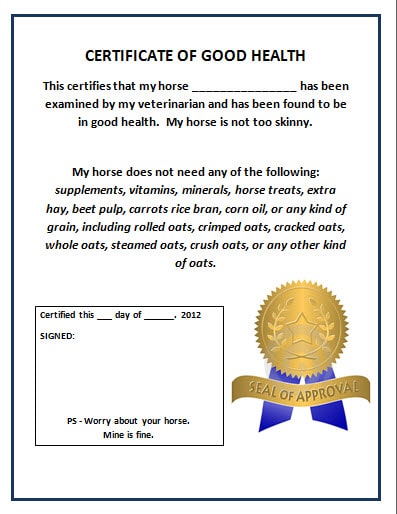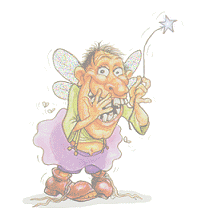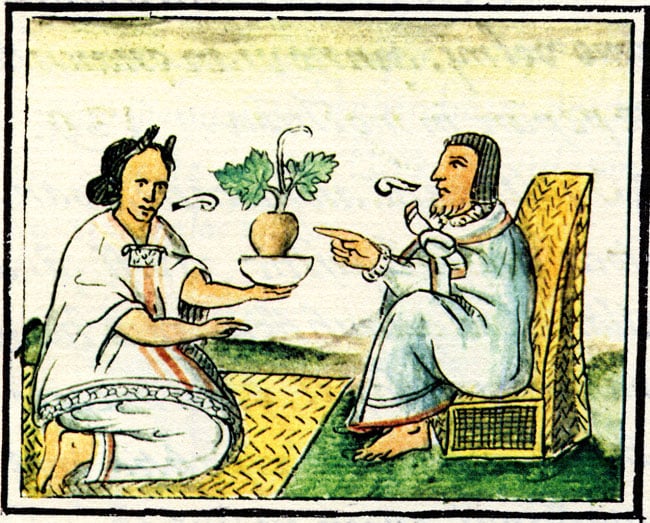If you happen to keep your horse in any sort of facility that caters to the public, you have probably figured out that there are lots of people at the facility who have ideas on the best way for you to take care of your horse. Never mind that you haven’t asked them for their ideas, or that you have a pretty good idea what you’re doing, or that, really, it’s your own horse, you really care about your horse, and you can do pretty much what you darn well please (thank you), but every barn seems to have at least one earnest and eager individual who has more than a passing interest in what’s going on with your horse. Some might call them “barn angels.” Others might not be nearly as charitable.
However, from a veterinary perspective, these “helpful” folk often serve as a way to make life more difficult. Here’s how things often go.
I’ve been called to examine a horse. After a thorough exam, backed by many years of experience, in addition to my professional education, I choose to make some recommendations. I carefully give my instructions, answer any questions, and head down the road, happy and confident that I’ve helped another horse. However…
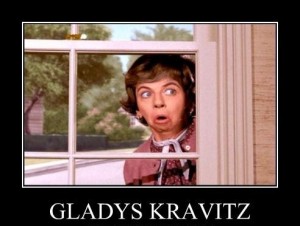
For more about Gladys, CLICK HERE
As soon as I leave, the resident barn angel materializes to speak to you. Offering a sympathetic ear, the barn angel listens to your story with great compassion, nods knowingly, and will usually say something like, “You know, my Uncle Fred’s best friend’s wife had a horse about 12 years ago that had something that sounds an awful like what your horse may have. But they didn’t do anything like what your vet said to do.”
Happily, there are some folks who have the ability to recognize that – especially in this situation – “barn angel” is just a euphemism for “busybody.” They may listen to the angel’s opinions, but are confident enough in our veterinarian-client relationship to put their faith in me. These situations usually turn out great.
However, there are other folks who, upon learning of the 1) quick, 2) easy, 3) inexpensive, and 4) successful resolution of the not-too-dissimilar sounding condition that occurred in a distant acquaintance’s horse many moons ago, decide that, in spite of the “angels” inability to remember any of the important details, and in spite of my expertise, they will come firmly on the side of the well-meaning interloper (who, by the way, also doesn’t charge for the advice). It’s annoying.
So, after much thought, I think that I’ve come up with a way to help. Instead of asking or expecting that the veterinary-client bond is strong enough to withstand such well-meaning, although somewhat fuzzy, advice, and instead of expecting you to put yourself in the awkward position of telling the “angel” to fly away and mind his or her own business, I’m offering several certificates for you to post on your horse’s stall – I’d suggest laminating them, to make sure they don’t get too torn up – to provide both protection for you (from the “angels”) as well as to provide reassurance that, most likely, everything is going to be OK.
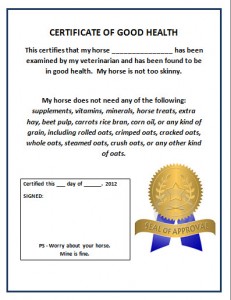
Certificate of Good Heath
For the life of me, I do not understand why people want to keep their horses fat. People seem to have this idea that it’s good to have a pudgy Palomino, a tubby Trahehner, or a hefty Holsteiner. You can read about fat horses if you CLICK HERE. On the other hand, some folks seem to think that one good way to save money on horse ownership is to forget to feed the horse. I’m certainly not in favor of obese Oldenburgs, but I’m not a big fan of anorexic Arabians either.* CLICK HERE to read about skinny horses.
Still, many horse owners seem surprised to learn that the ideal body condition for a horse is probably thinner than they realize; you should be able to feel your horses ribs easily. In fact, in some older horses, it may even be good to see a little rib – it’s easier on the old guys to carry less weight (and, in every species studied, including humans, animals that are slightly underweight live longer than their heavier cohorts).
So, in hopes that you can avoid unnecessary interactions with those that are intent on telling you that your horse doesn’t look right, and that you need to feed at least 14 different supplements and feeds to get your horse looking “just right,” I offer you this certificate of good health. CLICK HERE to see and print it.
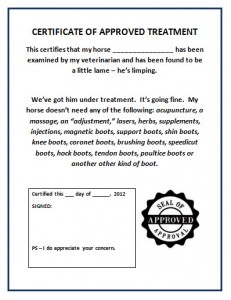 CERTIFICATE #2 – CERTIFICATE OF TREATMENT
CERTIFICATE #2 – CERTIFICATE OF TREATMENT
If something is wrong with your horse, you’re going to be worried. You’re going to be worried that he’s in pain, or that he doesn’t feel well, or that you and your horse won’t be able to spend those wonderful bonding moments together such as when he’s looking suspiciously at the small, but perhaps-800-feet-deep-puddle that has appeared on the trail, and is threatening him with a watery grave.
You’ll feel especially anxious if your horse is lame, and you’ll undoubtedly want to know why. Hopefully, if something is wrong, you’ll call your veterinarian who, hopefully, will help you understand and deal with your horse’s problem as quickly and inexpensively as possible. Of course, it won’t stop there. You’ll soon be besieged with advice on different treatments that might “help.” And your horse most likely won’t benefit from any of them – they’ll just be an expensive waste of time.
Not to worry. I offer you here a “Certificate of Treatment,” so that everyone will know that your horse has been taken care of, and that you’ve already thought of everything. CLICK HERE to get it.
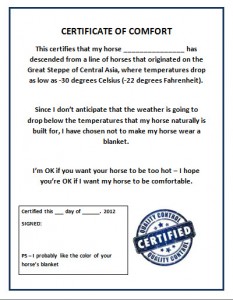 CERTIFICATE #3 – CERTIFICATE OF COMFORT
CERTIFICATE #3 – CERTIFICATE OF COMFORT
I don’t know if you put a blanket on your horse, but, honestly, it really makes no sense, at least not from the standpoint of your horse’s health. I mean, sure, if there are pigeons pooping on your horse all the time, a blanket will help keep your horse from looking like a remote rock in the ocean. Or, if you just can’t get enough of bright colors, there’s nothing like covering your horse up in a fetching pink-hued blanket to make your trip to the barn something to really look forward to. CLICK HERE to read about blanketing horses.
Honestly, though, you probably couldn’t make your horse cold enough to need a blanket if you wanted to. Remember, these guys are the descendants of animals that originated on the Great Steppe of Central Asia, where wintertime temperatures often dropped to a balmy 30 degrees below zero. Think Gengis Khan had the Mongol Horde blanketing their noble steeds on those long winter’s nights? You almost certainly don’t have to – and you don’t have to sleep in a yurt, or wear those pointed fur hats either.** So, if you don’t want to blanket your horse, and you do want to try to keep the barn angels at bay, CLICK HERE to get it.
I hope this helps. Or, maybe I just opened a whole ‘nother can of worms. Sigh.
***********************************************************************************************************
* Don’t these alliterative descriptions sound like they have the makings of a fun parlor game?
** The pointed top of the hat represents Mount Sumber, the legendary land of the Mongol forefathers. You are ready for trivia night now!

